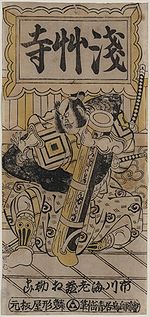
Torii Kiyomasu II
Encyclopedia

was a Japanese ukiyo-e
Ukiyo-e
' is a genre of Japanese woodblock prints and paintings produced between the 17th and the 20th centuries, featuring motifs of landscapes, tales from history, the theatre, and pleasure quarters...
painter and woodblock printmaker
Woodblock printing in Japan
Woodblock printing in Japan is a technique best known for its use in the ukiyo-e artistic genre; however, it was also used very widely for printing books in the same period. Woodblock printing had been used in China for centuries to print books, long before the advent of movable type, but was only...
of the Torii school
Torii school
This article is about a school of ukiyo-e art; for the sculpture style, see Tori style. For the Torii samurai clan, see Torii family.The Torii school was a school of ukiyo-e painting and printing founded in Edo...
, a specialist, like the rest of the Torii artists, in billboards and other images for the promotion of the kabuki
Kabuki
is classical Japanese dance-drama. Kabuki theatre is known for the stylization of its drama and for the elaborate make-up worn by some of its performers.The individual kanji characters, from left to right, mean sing , dance , and skill...
theatres. Scholars are unsure as to Kiyomasu II's relation to the original Kiyomasu
Torii Kiyomasu
was a Japanese painter and printmaker of the Torii school, in the genre of ukiyo-e. Like the other Torii artists, his primary focus was on Kabuki billboards, advertisements, actor prints, and other related material...
who came a few decades earlier; they may have been close relations, or master and student, or they may have been the same man.
His prints, like many at the time, were made largely using the urushi-e
Urushi-e
Urushi-e , literally meaning "lacquer picture," refers to two types of Japanese artworks: paintings painted with actual lacquer, and particular woodblock printing styles which use regular ink but are said to resemble the darkness and thickness of black lacquer.-Prints:Urushi-e woodblock prints were...
(lacquer print) and benizuri-e
Benizuri-e
' are a type of “primitive” ukiyo-e style Japanese woodblock prints. They were usually printed in pink and green, occasionally with the addition of another color, either printed or added by hand. The production of benizuri-e reached its peak in the early 1740s...
(rose print) methods; the lines or outlines of the prints themselves would often be in monochrome or a limited number of colors and the rest would be done by hand.
Richard Lane
Richard Douglas Lane
Richard Lane was an American scholar, author, collector, and dealer of Japanese art. He lived in Japan for much of his life, and had a long association with the Honolulu Academy of Arts in Hawaii, which now holds his vast art collection.-Life:...
writes that the majority of Kiyomasu's work is "quite stereotyped, lacking in vitality or fertility of invention." He writes the same of the works of Torii Kiyonobu II, but says of both artists that "in perhaps a quarter of their prints they manage to rise above the confines of their own limited talents and proude work of rare grace and charm."

